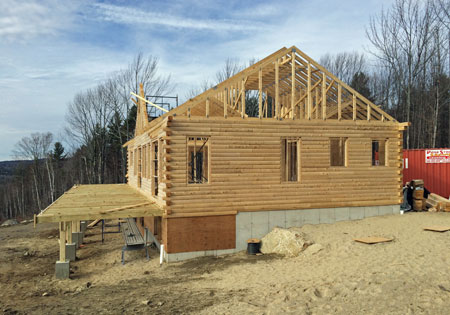Building On Your Unique Lot
Posted by Ward Cedar Log Homes in Log Homes
Building on Your Unique Lot: What You Need to Know
One of the most wonderful things about building a log home is that it can be customized to your specific needs and preferences — and the same goes for your lot. Just as no two homeowners are alike, each lot comes with its own unique considerations.
If you haven’t chosen a property, it can be helpful to keep the following guidelines in mind to guide you towards the right location for your log home. If you have already purchased a home site, use this information to navigate the early stages of building on your lot.
Get the Scoop
Whether you’re building a weekend cottage on the lake or a cozy cabin in the mountains, you will want to know the ins and outs of your specific property. It is essential that you perform a soil percolation test and gather information about your lot’s existing easements and any existing environmental issues. These are especially essential factors if you will be installing a septic system, digging a well, or need to establish electrical service on your land. Typically, your city or county’s planning and zoning/engineering department will have records that show relevant information. In addition to in-person requests, a copy of your property’s records can often be ordered online or through the mail.
Clear It Out
If you plan to build on a developed lot or on prairie or desert-like terrain, you may not have to remove a significant amount of brush around your property. But most homeowners will need to have an excavation expert clear the area around your home’s footprint. Generally, a 30-foot perimeter is recommended. This will protect your home from the potential of falling trees in the future, as well as create a more accessible site during building. At times, special trees or landscape features can be preserved, but be sure to note these during the land clearing process.
Check the Weather
Your property’s local climate will likely have a significant impact on the design features for your new log home. A house located in a sunny, temperate climate may call for lots of outdoor living space, such as porches, decks, and patios, while a home in a colder locale may beg for a wood-burning fireplace, a four-seasons room, or a generous mudroom. Thankfully, Ward’s northern white cedar logs, some of nature’s best insulators, are ideal in either environment due to their ability to keep heat inside on chilly days and maintain cool interior temperatures on sweltering ones.
Proper Placement
The placement of your home on your specific lot is one of the most important decisions you will make in the planning and building of your home. Siting the house to take full advantage of the views is often the driving force behind placement, but there are plenty of other important factors. If superior energy efficiency is at the top of your building wish list, you will also want to consider the passive solar design principles that suit your lot, as well as practical considerations, such as the budgeting costs of adding driveway to access your home.
When you plan with these factors in mind, your lot will only enhance the log home of your dreams. Got questions? Reach out to see how our expert team can walk you through each step of the planning and building process.


Post Your Comment